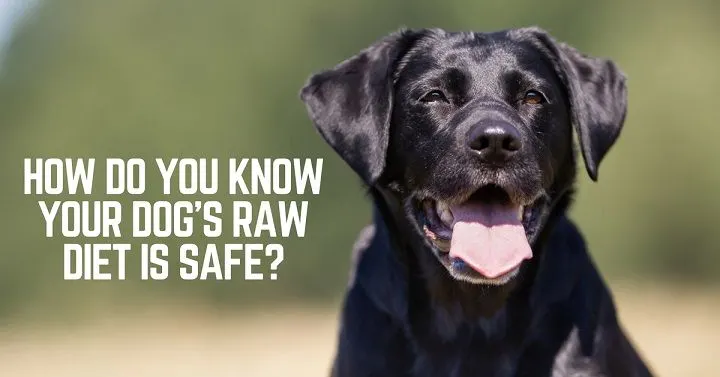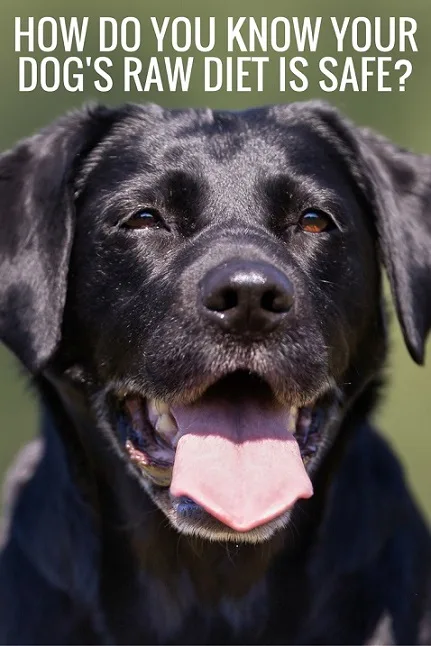Feeding your dog a raw diet means just that—a diet of raw meat, bones and sometimes fruits & veggies.
The reason some pet owners feed a raw diet is because dogs and cats are naturally designed for eating raw meat, and raw food contains more nutrients than cooked food.
Dogs and cats can handle more bacteria in their food than people can because their digestive systems are made for handling raw meat! (Think about a cat eating a mouse.)
I’ve been feeding my senior dog Ace a raw diet off and on for years without any issues.
Still, I have a few concerns.
For example, to save money I buy raw meat for my dogs from a grocery store because it’s generally less expensive than food from a raw dog food company. (My dogs eat a combination of homemade raw, commercial raw and also dry food.)
I am a little concerned about grocery store meat because sometimes the meat sits out on display for several days, and this gives bacteria additional time to grow. Since this meat is intended for people (to be cooked!), this is a non-issue as far as food safety for people is concerned.

Whenever I buy grocery store meat for my dogs, I either buy meat that is already frozen or I put it in my freezer for a week or so. This won’t kill all the bacteria—cooking the meat is the only way to do that at home—but it does help.
For those of you who feed homemade raw, do you have any concerns about grocery store meat? Have yours dogs ever gotten sick? Do you have any safety tips to share? Let me know in the comments as I could use some tips myself.
Other tips:
- Find out exactly where the food is coming from (ask).
- Ask how long it sits out on average.
- Try to buy the freshest ingredients made as locally as possible.
When in doubt, you can always cook the meat. Dogs CAN eat cooked food, obviously. But the whole point of feeding raw is the benefit of all the nutrients and enzymes in fresh food.
Less bacteria in commercial raw dog food brands
My dog Ace has an autoimmune disease called panniculitis that can cause sores to open up on his body. To keep this under control he’s on a medication called Atopica. I’m thankful the medication is helping him but it also suppresses his immune system, making him more vulnerable to getting sick.
Because of this, I am careful about what I feed Ace. (I don’t worry much about my young, healthy dog Remy.)
Balanced Blends safe raw diets
Balanced Blends is a new company in Colorado focused on providing balanced, SAFE raw diets for dogs and cats so pet owners can feed raw without any worry. This is especially important for those who are new to raw feeding and might be more nervous about it. Like I said, it’s also helpful for those who have pets with compromised immune systems like Ace.
Balanced Blends said it does the following for extra safe raw diets:
1. Fresh ingredients. It starts with fresh ingredients and makes the food in a refrigerated facility.
2. High pressure processing. The final product is applied with high pressure processing (HPP) in its final packaging. It is not turned into patties or nuggets afterwards, eliminating the risk of recontamination.
HPP use high pressure to eliminate food borne pathogens without using any heat, according to Balanced Blends. Since it does not use chemicals or preservatives, HPP is a natural anti-pathogen treatment that causes very little change to the nutrients in the food.
The process is recognized by the FDA and USDA as a safe anti-pathogen treatment for natural and organic food, according to Balanced Blends.
3. Test and hold protocol. All food is lab tested by a third party and only sold after it tests negative for harmful bacteria.
4. Lot tracking. The company has lot tracking for all its food so it is able to keep track of the specific ingredients that go into every batch.
Feeding commercial raw food is not for everyone, but it does eliminate some of the health concerns with dogs potentially getting sick from bacteria. You can also trust that the food is balanced. There are pros and cons to feeding both homemade raw or commercial raw, and a lot depends on your budget and your comfort level with the ingredients you buy on your own.
In the comments, let me know more about the raw food you feed your dog. It’s helpful for anyone interested in getting started.



chris
Tuesday 20th of December 2016
I have researched and HPP meat products do not have the same nutrition value as none HPP meats. So I would be hesistant to use a product for my dogs that is HPP processed. I am very open minded and have only seen articles stating it is bad so I am open if you have sources that can state it is not. I am always learning especially when it comes to my dogs. I also have learned that HPP is bad for humans too.
Lindsay Stordahl
Thursday 22nd of December 2016
There are pros and cons to hpp. Pet owners should do their own research as you have done and decide what is best for their own dogs. HPP kills all harmful bacteria in the meat without cooking it. However, it alters the nutrients slightly. Most healthy dogs can handle the bacteria on raw meat but hpp is the best way to guarantee safety without cooking the meat. Raw feeders have different comfort levels with bacteria, and that goes for the dogs themselves but also humans who might handle the meat or have contact with the dog. For me personally, my concern is the safety of my senior dog. Due to his weakened immune system, I am not comfortable feeding him meat that potentially contains harmful bacteria that could make him really sick. I'm not an expert on hpp by any means and will reach out to balanced blends to see if it has additional input.